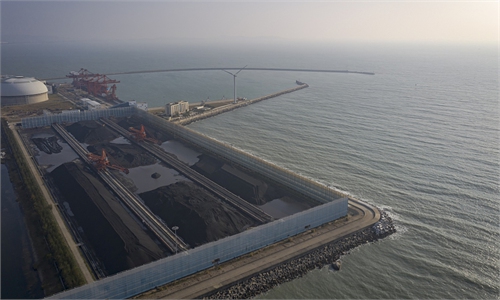China to adjust coal-fired electricity prices, encourage regions to boost production to ensure energy supply

Photo:VCG
China will make flexible adjustments to allow market-based coal-fired electricity prices to be raised by up to 20 percent from the benchmark, part of its efforts aimed at guaranteeing winter heat and electricity supply while several coal-producing provinces such as North China's Inner Mongolia Autonomous Region have already moved to boost the production.
In view of the relatively great coal and electricity supply pressure this winter and next spring, a State Council executive meeting chaired by Premier Li Keqiang on Friday announced a series of targeted arrangements to enhance energy supply security.
The meeting called for efforts to support coal-fired power plants to increase power supply by encouraging financial institutions to ensure the reasonable financing needs of coal-fired power plants and improving the market-based pricing mechanism of coal-fired electricity. Specifically, on the premise of keeping the electricity prices stable for residents, agriculture and public welfare undertakings, the fluctuation range of market-traded electricity prices will be expanded to no more than 20 percent higher from the benchmark price in principle. For high energy-consuming industries, electricity prices can be formed through market transactions, without the 20 percent fluctuation limit.
At the beginning of 2020, China adopted a market-based electricity price mechanism composed of benchmark and fluctuating prices. The benchmark is determined by the on-grid price of each region and the fluctuation was originally set between 10 percent higher and 15 percent lower of the benchmark.
The move targets the central problem in the recent power blackouts by shifting part of the cost pressure to downstream users, according to experts.
"The shortage of coal supplies has resulted in soaring coal prices, driving coal-fired power plants into serious losses," Lin Boqiang, director of the China Center for Energy Economics Research at Xiamen University, told the Global Times. "Power plants are less motivated to increase electricity supply as they're seeing losses balloon."
On the other side, the meeting urged coal mines that have potential to increase production to expedite the release of production capacity on the premise of ensuring production safety.
Several coal-producing provinces have already moved to boost coal output amid the energy shortage. In particular, authorities from North China's Inner Mongolia Autonomous Region this week notified 72 coal mines to increase production capacity by 98.35 million tons.
But the challenges to secure coal supplies remain huge. Due to the heavy rainfalls in North China's Shanxi Province, which is the country's largest coal production region, over the past week, 60 coal mines have suspended operations and local coal transport has also been affected, according to media reports. According to the National Bureau of Statistics, Shanxi produced 1.063 billion tons of coal in 2020.
"While domestic production remains unstable due to emission reduction work and weather factors, imported coal is priced too high. As the demand is rising rapidly, so overall, the tight coal supply will continue for some time," Lin said.
Global Times



